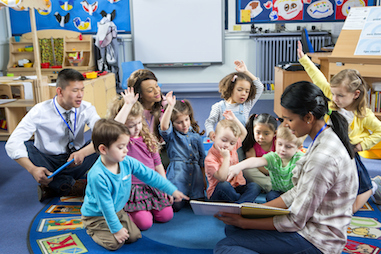4 Strategies to Help Children Reconstruct Stories


“The mama hen was super frustrated cause mamas always have to do all the hard work by themselves. But that’s why they get to eat all the bread!”
I bet any preschool teacher knows what story this child is reconstructing. First published in 1874, The Little Red Hen has been a constant in early childhood collections for centuries.
Its simple and repetitive language—“Not I,” said the Dog; “Not I,” said the Cat; “Not I,” said the Goose—make it an inviting story for children to join in and participate as early readers. Its progressive steps of planting, harvesting, and turning the wheat into flour to bake bread work well for using flannel stories to have children sequence and retell the story. But more nuanced are its underlying themes of the importance of hard work, taking pride in your own persistence, and recognizing the need to help others.
Retelling vs. Reconstructing
Engaging children in repeated chorus dialogue and holding up images from the story for children to place in order encourages them to retell the story, and retelling stories is an important skill. But it’s not enough. If we want to nurture rich reading and comprehension strategies, we need to encourage children to not simply retell a story but to reconstruct a story. When children reconstruct stories, they don’t merely recall the events and dialogue. They make inferences into characters’ feelings and motivations and use that deeper understanding to make connections within a story as well as to their own lives—making the social–emotional themes of stories much more impactful.
Retelling The Little Red Hen by a child sounds something like this.
“There once was a farm with a hen, a dog, a cat, and a goose. One day, the hen found some seeds and asked who would help her plant them. “Not I,” said the animals. So, the hen did it by herself. Then she asked who would help harvest the wheat. All the animals said, “Not I!” again, so she did it herself. The hen finished baking the bread and told everyone they couldn’t eat any. Next time, they helped her.”
Reconstructing The Little Red Hen by a child sounds more like this:
“There once was a farm where the hen did all the work. She found a seed and was excited to plant it so she could make some tasty bread. She asked her friends to help her. Well, they really weren’t her friends because they weren’t very nice when she asked for their help, and friends should help each other. Like how I helped Pedro when he spilled his milk yesterday. When the bread was done cooking, the hen didn’t share her bread because she wanted to teach the animals that you don’t get to enjoy the bread if you don’t help do any of the hard work. That way, next time they will remember to help her if she finds another seed.”
Using the repeated read-aloud approach allows for more focus in subsequent readings on characters’ feelings and motivations, which encourages children to analyze and internalize the meaning and social–emotional themes of the story.
You can encourage story reconstruction by wondering aloud and posing questions for reflection and discussion.
- “I wonder why the Little Red Hen asked for help harvesting the wheat when she already knows her friends aren’t very helpful. Maybe she thought they would say yes this time.”
- “Why do Dog, Goose, and Cat keep saying no when Little Red Hen asks for help?”
- “What do you think would happen if Dog, Cat, or Goose asked Little Red Hen for help with a job? What would she do? What would you do?”
- “What lesson did Dog, Cat, and Goose learn? How do you feel when someone helps you? How do you feel when someone refuses to help you?”
How do you use repeated read-alouds in your classroom?

Literature Both Inside and Outside the Classroom
Teaching Strategies is committed to providing children with robust, equitable, and accessible children’s literature for the classroom and at home with our Digital Children’s Library in The Creative Curriculum Cloud.